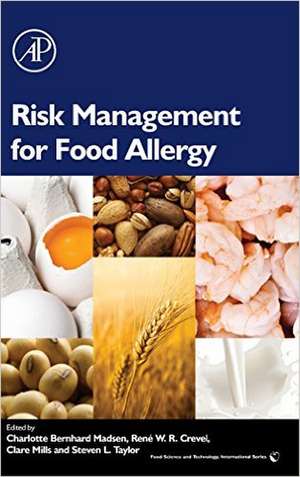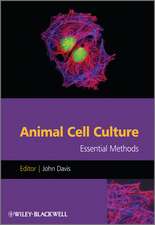Risk Management for Food Allergy
Editat de Charlotte Madsen, Rene Crevel, Clare Mills, Steve Tayloren Limba Engleză Hardback – 8 ian 2014
With more than 12 million Americans suffering from food allergies and little indication of what is causing that number to continue to grow, food producers, packagers and distributors need to appropriately process, label and deliver their products to ensure the safety of customers with allergic conditions. By identifying risk factors during processing as well as determining appropriate "safe" thresholds of ingredients, the food industry must take increasingly proactive steps to avoid direct or cross-contamination as well as ensuring that their products are appropriately labeled and identified for those at risk.
This book covers a range of critical topics in this area, including the epidemiology of food allergy, assessing allergen thresholds and risk, specifics of gluten management and celiac disease, and much more. The practical advice on factory risk management, catering industry practices, allergen detection and measurement and regulatory controls is key for food industry professionals as well as regulators in government and other public bodies.
- Science-based insights into the potential risks of food allergens
- Focused section on determining thresholds
- Practical guidance on food allergen risk management, including case studies
Preț: 607.20 lei
Preț vechi: 850.47 lei
-29% Nou
Puncte Express: 911
Preț estimativ în valută:
116.20€ • 120.63$ • 96.89£
116.20€ • 120.63$ • 96.89£
Carte tipărită la comandă
Livrare economică 17-31 martie
Preluare comenzi: 021 569.72.76
Specificații
ISBN-13: 9780123819888
ISBN-10: 0123819881
Pagini: 330
Ilustrații: black & white tables, figures
Dimensiuni: 152 x 229 x 18 mm
Greutate: 0.45 kg
Editura: Elsevier
ISBN-10: 0123819881
Pagini: 330
Ilustrații: black & white tables, figures
Dimensiuni: 152 x 229 x 18 mm
Greutate: 0.45 kg
Editura: Elsevier
Public țintă
Persons involved in managing the risk of food allergy in industry, government and other public bodies (control) and catering (not patients managing their own risk).Cuprins
Section 1: Food Allergy: causes, prevalence and impacts
Chapter 1: Living with Food Allergy: Cause for concern
Chapter 2: Which foods cause food allergy and how is food allergy treated?
Chapter 3: The Epidemiology of Food Allergy
Section 2: Allergen thresholds & risk assessment
Chapter 4: How to determine thresholds clinically
Chapter 5: Thresholds or "how much is too much"
Chapter 6: From hazard to risk - Assessing the risk
Section 3: Risk management of gluten
Chapter 7: Coeliac disease and risk management of gluten
Section 4: Practical food allergen risk management
Chapter 8: Food Allergen Risk Management in the Factory - from ingredients to products
Chapter 9: Managing food allergens. Case histories and how they were handled
Chapter 10: Catering – how to keep allergic customers happy and safe?
Chapter 11: Food Allergen Risk Management in the United States and Canada
Chapter 12: The importance of food allergy training for Environmental Health Service professionals
Chapter 13: Detecting and measuring allergens in food
Chapter 14: Effect of Processing on the Allergenicity of Foods
Chapter 15: Communication with Food Allergic Consumers: A Win-Win Experience
Chapter 16: May contain – to use or not?
Chapter 17: Regulatory Controls for Food Allergens
Chapter 18: Keeping updated
Chapter 1: Living with Food Allergy: Cause for concern
Chapter 2: Which foods cause food allergy and how is food allergy treated?
Chapter 3: The Epidemiology of Food Allergy
Section 2: Allergen thresholds & risk assessment
Chapter 4: How to determine thresholds clinically
Chapter 5: Thresholds or "how much is too much"
Chapter 6: From hazard to risk - Assessing the risk
Section 3: Risk management of gluten
Chapter 7: Coeliac disease and risk management of gluten
Section 4: Practical food allergen risk management
Chapter 8: Food Allergen Risk Management in the Factory - from ingredients to products
Chapter 9: Managing food allergens. Case histories and how they were handled
Chapter 10: Catering – how to keep allergic customers happy and safe?
Chapter 11: Food Allergen Risk Management in the United States and Canada
Chapter 12: The importance of food allergy training for Environmental Health Service professionals
Chapter 13: Detecting and measuring allergens in food
Chapter 14: Effect of Processing on the Allergenicity of Foods
Chapter 15: Communication with Food Allergic Consumers: A Win-Win Experience
Chapter 16: May contain – to use or not?
Chapter 17: Regulatory Controls for Food Allergens
Chapter 18: Keeping updated














